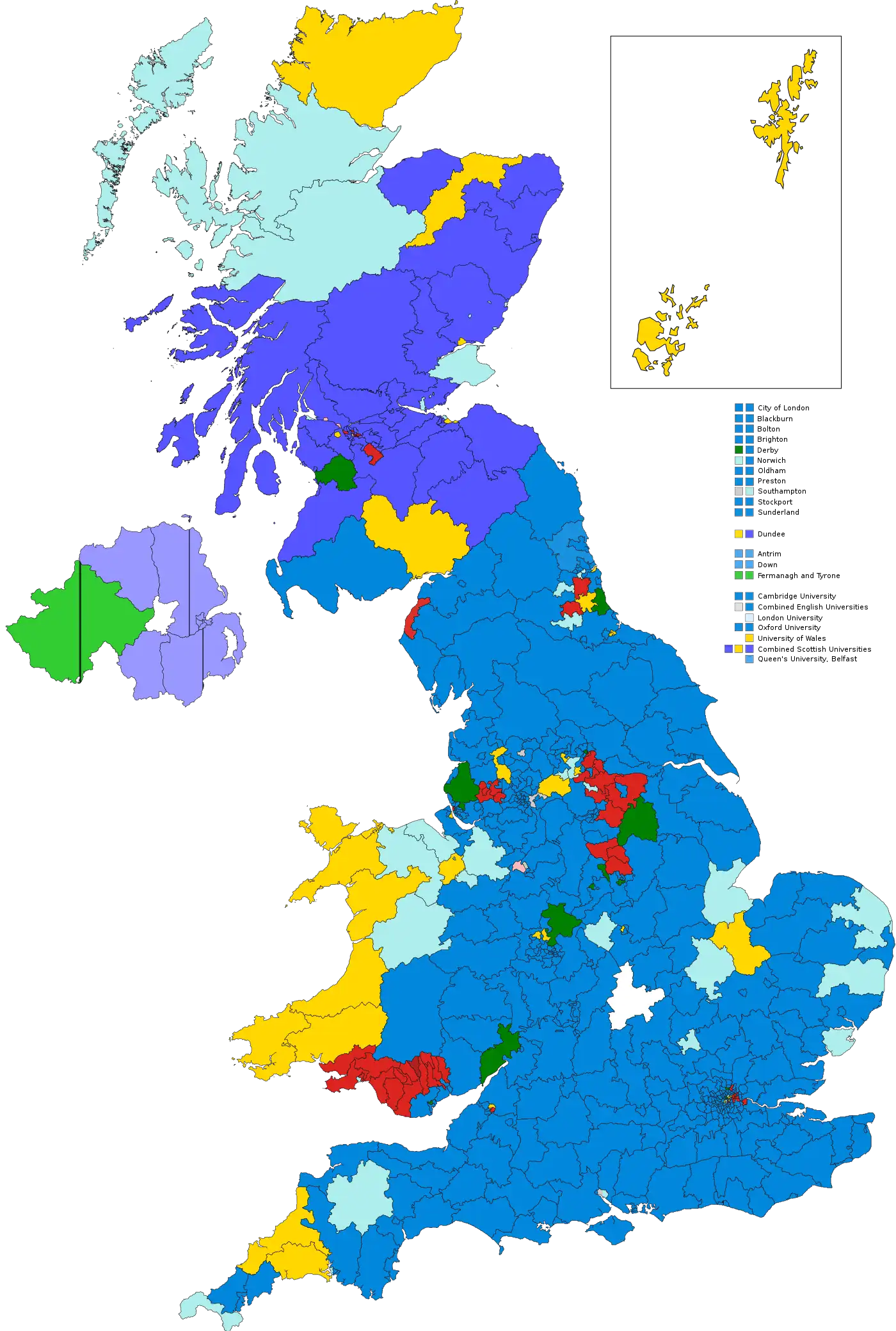Bristol East (UK Parliament constituency)
Bristol East is a constituency[n 1] recreated in 1983 covering the eastern part of the City of Bristol, represented in the House of Commons of the UK Parliament since 2005 by Kerry McCarthy of the Labour Party.[n 2]
| Bristol East | |
|---|---|
| Borough constituency for the House of Commons | |
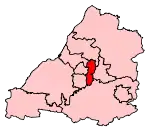 Boundary of Bristol East in Avon for the 2010 general election | |
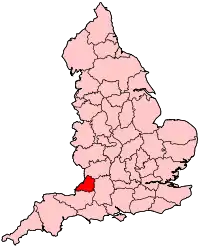 Location of Avon within England | |
| County | City of Bristol |
| Population | 95,368 (2011 census)[1] |
| Electorate | 70,366 (2018)[2] |
| Current constituency | |
| Created | 1983 |
| Member of Parliament | Kerry McCarthy (Labour) |
| Seats | One |
| Created from | Bristol South East Bristol South Bristol North East[3] |
| 1885–1950 | |
| Seats | One |
| Type of constituency | Borough constituency |
| Created from | Bristol |
| Replaced by | Bristol South East, Bristol Central and Bristol South |
Constituency profile
Bristol East covers Fishponds, St Anne's and Brislington.
History
First creation
The seat was first created in 1885[n 3]. Boundaries were slightly altered in 1918 and Bristol East was abolished in a comprehensive review of the local seats for the 1950 general election.
- Political history
The most powerful representative of Bristol East in Parliament and H.M. Government was Sir Stafford Cripps, MP (Lab) 1931–1950, who was Chancellor of the Exchequer from 1947 to 1950. The seat shifted from Liberal Party representation through to the Labour Party with the 1918-1923 period seeing a more centrist Liberal splinter group candidate elected.
Second creation
The seat was recreated in 1983 on much larger boundaries than before 1950, reflecting the lower occupation levels of the city centre and allocation of new seats elsewhere to reflect population expansion mainly in former rural and lightly populated suburban areas.
- Political history
The 1983 election, the first in the recreated East seat, was a landslide victory for Margaret Thatcher's Conservatives following retention of the Falkland Islands in the Falklands War. Bristol East returned a Conservative MP, as Jonathan Sayeed defeated Tony Benn, the outgoing MP for Bristol South East and the leader of a large faction on the left-wing of the Labour Party. In 1992 Labour's Jean Corston gained the seat from Sayeed, which has been retained by Labour candidates at each subsequent general election, the Conservatives coming second, except in 2005, when the Liberal Democrats did so.[n 4] The 2015 result gave the seat the 42nd-smallest majority of Labour's 232 seats by percentage of majority;[4] however, in 2017, incumbent MP Kerry McCarthy more than tripled her majority, winning the largest share of the vote in the seat's history and by the biggest margin since 1997.
- Turnout
Turnout has ranged between 80.3% in 1992 to 57.4% in 2001.
- Other parties
Five parties' candidates achieved more than the deposit-retaining threshold of 5% of the vote in 2015. Liberal Democrat candidate Philip James won the largest third-party share of the vote to date, in the 2005 election — 25.2% of the vote.
Boundaries
1885–1918: The Municipal Borough of Bristol ward of South, part of North ward, and the local government district of St George.
1918–1950: The County Borough of Bristol wards of St George East and St George West, and parts of Easton, and Somerset wards.
1983–1997: The City of Bristol wards of Brislington East, Brislington West, Easton, Eastville, Hengrove, Lawrence Hill, and Stockwood.
1997–2010: The City of Bristol wards of Brislington East, Brislington West, Easton, Eastville, Lawrence Hill, St George East, St George West, and Stockwood.
2010–present: The City of Bristol wards of Brislington East, Brislington West, Eastville, Frome Vale, Hillfields, St George East, St George West, and Stockwood.
The constituency covers the eastern part of the city of Bristol, from neighbourhoods of the City Centre to outer neighbourhoods (excluding surrounding settlements in local government administratively).
Members of Parliament
MPs 1885–1950
| Election | Member[5] | Party | |
|---|---|---|---|
| 1885 | Handel Cossham | Liberal | |
| 1890 by-election | Sir Joseph Dodge Weston | Liberal | |
| 1895 by-election | Sir William Wills, Bt | Liberal | |
| 1900 | Charles Hobhouse | Liberal | |
| 1918 | George Britton | Coalition Liberal | |
| 1922 | Harold Morris | National Liberal | |
| 1923 | Walter Baker | Labour | |
| 1931 by-election | Sir Stafford Cripps | Labour | |
| 1939 | Independent Labour | ||
| 1945 | Labour | ||
| 1950 | constituency abolished – see Bristol South East | ||
MPs 1983–present
| Election | Member[6] | Party | |
|---|---|---|---|
| 1983 | Jonathan Sayeed | Conservative | |
| 1992 | Jean Corston | Labour | |
| 2005 | Kerry McCarthy | Labour | |
Elections
Elections in the 2010s
| Party | Candidate | Votes | % | ±% | |
|---|---|---|---|---|---|
| Labour | Kerry McCarthy | 27,717 | 53.1 | -7.6 | |
| Conservative | Sarah Codling | 16,923 | 32.4 | -2.0 | |
| Liberal Democrats | Nicholas Coombes | 3,527 | 6.8 | +4.1 | |
| Green | Conan Connolly | 2,106 | 4.0 | +1.8 | |
| Brexit Party | Tim Page | 1,881 | 3.6 | New | |
| Majority | 10,794 | 20.7 | -5.6 | ||
| Turnout | 52,154 | 70.6 | +0.4 | ||
| Labour hold | Swing | -2.9 | |||
| Party | Candidate | Votes | % | ±% | |
|---|---|---|---|---|---|
| Labour | Kerry McCarthy | 30,847 | 60.7 | +21.4 | |
| Conservative | Theo Clarke | 17,453 | 34.4 | +3.7 | |
| Liberal Democrats | Chris Lucas | 1,389 | 2.7 | -3.1 | |
| Green | Lorraine Francis | 1,110 | 2.2 | -6.1 | |
| Majority | 13,394 | 26.3 | +17.7 | ||
| Turnout | 50,799 | 70.2 | +6.0 | ||
| Labour hold | Swing | +8.9 | |||
| Party | Candidate | Votes | % | ±% | |
|---|---|---|---|---|---|
| Labour | Kerry McCarthy | 18,148 | 39.3 | +2.7 | |
| Conservative | Theo Clarke | 14,168 | 30.7 | +2.4 | |
| UKIP | James McMurray | 7,152 | 15.5 | +12.1 | |
| Green | Lorraine Francis[11] | 3,827 | 8.3 | +6.5 | |
| Liberal Democrats | Abdul Malik | 2,689 | 5.8 | −18.6 | |
| TUSC | Matt Gordon[12] | 229 | 0.5 | +0.1 | |
| Majority | 3,980 | 8.6 | +0.3 | ||
| Turnout | 46,213 | 64.2 | −0.6 | ||
| Labour hold | Swing | +0.2 | |||
| Party | Candidate | Votes | % | ±% | |
|---|---|---|---|---|---|
| Labour | Kerry McCarthy | 16,471 | 36.6 | −8.9 | |
| Conservative | Adeela Shafi | 12,749 | 28.3 | +0.2 | |
| Liberal Democrats | Mike Popham | 10,993 | 24.4 | +4.7 | |
| BNP | Brian Jenkins | 1,960 | 4.4 | New | |
| UKIP | Philip Collins | 1,510 | 3.4 | +0.7 | |
| Green | Glenn Vowles | 803 | 1.8 | −0.9 | |
| English Democrat | Stephen Wright | 347 | 0.8 | New | |
| TUSC | Rae Lynch | 184 | 0.4 | New | |
| Majority | 3,722 | 8.3 | |||
| Turnout | 45,017 | 64.8 | +1.8 | ||
| Labour hold | Swing | −4.5 | |||
Elections in the 2000s
| Party | Candidate | Votes | % | ±% | |
|---|---|---|---|---|---|
| Labour | Kerry McCarthy | 19,152 | 45.9 | −9.1 | |
| Liberal Democrats | Philip James | 10,531 | 25.2 | +8.1 | |
| Conservative | Julia Manning | 8,787 | 21.1 | −0.7 | |
| Green | Arjuna Krishna-Das | 1,586 | 3.8 | +1.0 | |
| UKIP | Jean Smith | 1,132 | 2.7 | +1.3 | |
| Respect | Paulette North | 532 | 1.3 | New | |
| Majority | 8,621 | 20.7 | -12.5 | ||
| Turnout | 41,720 | 61.3 | +3.9 | ||
| Labour hold | Swing | −8.6 | |||
| Party | Candidate | Votes | % | ±% | |
|---|---|---|---|---|---|
| Labour | Jean Corston | 22,180 | 55.0 | −1.9 | |
| Conservative | Jack Lopresti | 8,788 | 21.8 | −1.6 | |
| Liberal Democrats | Brian Niblett | 6,915 | 17.1 | +2.3 | |
| Green | Geoff Collard | 1,110 | 2.8 | New | |
| UKIP | Roger Marsh | 572 | 1.4 | New | |
| Socialist Labour | Michael Langley | 438 | 1.1 | -0.5 | |
| Socialist Alliance | Andrew Pryor | 331 | 0.8 | New | |
| Majority | 13,392 | 33.2 | -0.3 | ||
| Turnout | 40,334 | 57.4 | -12.3 | ||
| Labour hold | Swing | ||||
Elections in the 1990s
| Party | Candidate | Votes | % | ±% | |
|---|---|---|---|---|---|
| Labour | Jean Corston | 27,418 | 56.9 | +10.3 | |
| Conservative | Ed Vaizey | 11,259 | 23.4 | -15.8 | |
| Liberal Democrats | Peter Tyzack | 7,121 | 14.8 | -0.9 | |
| Referendum | Gerry Philip | 1,479 | 3.1 | New | |
| Socialist Labour | Paul Williams | 766 | 1.6 | New | |
| Natural Law | John McLaggan | 158 | 0.3 | New | |
| Majority | 16,159 | 33.5 | +28.1 | ||
| Turnout | 48,201 | 69.7 | -11.6 | ||
| Labour hold | Swing | +13.0 | |||
| Party | Candidate | Votes | % | ±% | |
|---|---|---|---|---|---|
| Labour | Jean Corston | 22,418 | 44.6 | +9.2 | |
| Conservative | Jonathan Sayeed | 19,726 | 39.2 | −4.4 | |
| Liberal Democrats | John Francis Kiely | 7,903 | 15.7 | −4.7 | |
| National Front | Ian Anderson | 270 | 0.5 | −0.1 | |
| Majority | 2,692 | 5.4 | N/A | ||
| Turnout | 50,317 | 80.3 | +1.6 | ||
| Labour gain from Conservative | Swing | +6.8 | |||
Elections in the 1980s
| Party | Candidate | Votes | % | ±% | |
|---|---|---|---|---|---|
| Conservative | Jonathan Sayeed | 21,906 | 43.6 | +3.1 | |
| Labour | Ronald Thomas | 17,783 | 35.4 | −1.5 | |
| Liberal | Don Foster | 10,247 | 20.4 | −0.9 | |
| National Front | Philip Kingston | 286 | 0.6 | −0.1 | |
| Majority | 4,123 | 8.2 | +4.6 | ||
| Turnout | 50,222 | 78.7 | +4.8 | ||
| Conservative hold | Swing | +2.3 | |||
| Party | Candidate | Votes | % | ±% | |
|---|---|---|---|---|---|
| Conservative | Jonathan Sayeed | 19,844 | 40.5 | ||
| Labour | Tony Benn | 18,055 | 36.9 | ||
| Liberal | Peter Tryer | 10,404 | 21.3 | ||
| National Front | Ernest Andrews | 343 | 0.7 | ||
| Ecology | Gundula Dorey | 311 | 0.6 | ||
| Majority | 1,789 | 3.6 | |||
| Turnout | 48,957 | 73.9 | |||
| Conservative win (new seat) | |||||
Elections in the 1940s
| Party | Candidate | Votes | % | ±% | |
|---|---|---|---|---|---|
| Labour | Stafford Cripps | 27,975 | 73.5 | +14.2 | |
| Conservative | T.D. Corpe | 10,073 | 26.5 | New | |
| Majority | 17,902 | 47.0 | +28.4 | ||
| Turnout | 37,768 | 76.3 | +0.5 | ||
| Labour hold | Swing | ||||
Elections in the 1930s
| Party | Candidate | Votes | % | ±% | |
|---|---|---|---|---|---|
| Labour | Stafford Cripps | 22,009 | 59.3 | +8.7 | |
| National Labour | Archibald Church | 15,126 | 40.7 | New | |
| Majority | 6,883 | 18.6 | +17.4 | ||
| Turnout | 37,135 | 75.8 | -4.4 | ||
| Labour hold | Swing | ||||
| Party | Candidate | Votes | % | ±% | |
|---|---|---|---|---|---|
| Labour | Stafford Cripps | 19,435 | 50.6 | -15.2 | |
| Conservative | James Spreull | 19,006 | 49.4 | N/A | |
| Majority | 429 | 1.2 | -30.4 | ||
| Turnout | 38,441 | 80.2 | +2.0 | ||
| Labour hold | Swing | ||||
| Party | Candidate | Votes | % | ±% | |
|---|---|---|---|---|---|
| Labour | Stafford Cripps | 19,261 | 61.7 | -4.1 | |
| Conservative | Peter Chapman-Walker | 7,937 | 25.4 | New | |
| Liberal | Edward Baker | 4,010 | 12.8 | -21.4 | |
| Majority | 11,324 | 36.3 | +4.7 | ||
| Turnout | 31,208 | ||||
| Labour hold | Swing | ||||
Elections in the 1920s
| Party | Candidate | Votes | % | ±% | |
|---|---|---|---|---|---|
| Labour | Walter Baker | 24,197 | 65.8 | +7.6 | |
| Liberal | Charles Gordon-Spencer | 12,576 | 34.2 | −7.6 | |
| Majority | 11,621 | 31.6 | +15.2 | ||
| Turnout | 36,773 | 78.2 | −1.6 | ||
| Registered electors | 47,039 | ||||
| Labour hold | Swing | +7.6 | |||

| Party | Candidate | Votes | % | ±% | |
|---|---|---|---|---|---|
| Labour | Walter Baker | 16,920 | 58.2 | +4.5 | |
| Liberal | Herbert John Maggs | 12,143 | 41.8 | −4.5 | |
| Majority | 4,777 | 16.4 | +9.0 | ||
| Turnout | 29,063 | 79.8 | +3.3 | ||
| Registered electors | 36,441 | ||||
| Labour hold | Swing | +4.5 | |||
| Party | Candidate | Votes | % | ±% | |
|---|---|---|---|---|---|
| Labour | Walter Baker | 14,828 | 53.7 | +4.0 | |
| Liberal | Harold Morris | 12,788 | 46.3 | −4.0 | |
| Majority | 2,040 | 7.4 | N/A | ||
| Turnout | 27,616 | 76.5 | −1.0 | ||
| Registered electors | 36,105 | ||||
| Labour gain from National Liberal | Swing | +4.0 | |||
| Party | Candidate | Votes | % | ±% | |
|---|---|---|---|---|---|
| National Liberal | Harold Morris | 13,910 | 50.3 | +0.7 | |
| Labour | Luke Bateman | 13,759 | 49.7 | +6.9 | |
| Majority | 151 | 0.6 | N/A | ||
| Turnout | 27,669 | 77.5 | +21.0 | ||
| Registered electors | 35,704 | ||||
| National Liberal gain from National Liberal | Swing | N/A | |||
Elections in the 1910s

| Party | Candidate | Votes | % | ±% | |
|---|---|---|---|---|---|
| National Liberal | George Britton | 9,434 | 49.6 | -13.3 | |
| Labour | Luke Bateman | 8,135 | 42.8 | New | |
| Liberal | Charles Hobhouse | 1,447 | 7.6 | -53.3 | |
| Majority | 1,299 | 6.8 | N/A | ||
| Turnout | 19,016 | 56.5 | -20.4 | ||
| National Liberal gain from Liberal | Swing | ||||
Election results 1885-1918
Elections in the 1910s
General Election 1914–15: Another General Election was required to take place before the end of 1915. The political parties had been making preparations for an election to take place and by July 1914, the following candidates had been selected;
- Liberal: Charles Hobhouse
- Unionist: Thomas Clarence Edward Goff[23]
- Independent Labour Party: Walter Ayles
| Party | Candidate | Votes | % | ±% | |
|---|---|---|---|---|---|
| Liberal | Charles Hobhouse | 4,913 | 62.8 | -0.1 | |
| Independent | Walter Moore | 2,913 | 37.2 | New | |
| Majority | 2,000 | 25.6 | -0.2 | ||
| Turnout | 7,826 | 52.3 | -24.6 | ||
| Registered electors | 14,951 | ||||
| Liberal hold | Swing | N/A | |||
| Party | Candidate | Votes | % | ±% | |
|---|---|---|---|---|---|
| Liberal | Charles Hobhouse | 7,229 | 62.9 | +10.9 | |
| Conservative | Patrick Hannon | 4,263 | 37.1 | +6.3 | |
| Majority | 2,966 | 25.8 | +4.6 | ||
| Turnout | 11,492 | 76.9 | −10.0 | ||
| Registered electors | 15,060 | ||||
| Liberal hold | Swing | −2.3 | |||
| Party | Candidate | Votes | % | ±% | |
|---|---|---|---|---|---|
| Liberal | Charles Hobhouse | 6,804 | 52.0 | −19.7 | |
| Conservative | Thomas Henry Batten | 4,033 | 30.8 | +2.5 | |
| Labour | Frank Sheppard | 2,255 | 17.2 | New | |
| Majority | 2,771 | 21.2 | -22.2 | ||
| Turnout | 13,092 | 86.9 | +10.8 | ||
| Registered electors | 15,060 | ||||
| Liberal hold | Swing | −11.1 | |||
Elections in the 1900s
| Party | Candidate | Votes | % | ±% | |
|---|---|---|---|---|---|
| Liberal | Charles Hobhouse | 7,935 | 71.7 | +15.3 | |
| Liberal Unionist | Thomas Bertram Johnston | 3,129 | 28.3 | −15.3 | |
| Majority | 4,806 | 43.4 | +30.6 | ||
| Turnout | 11,064 | 76.1 | +9.1 | ||
| Registered electors | 14,543 | ||||
| Liberal hold | Swing | +15.3 | |||
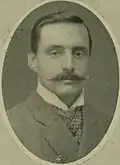
| Party | Candidate | Votes | % | ±% | |
|---|---|---|---|---|---|
| Liberal | Charles Hobhouse | 4,979 | 56.4 | −12.4 | |
| Conservative | Robert Sanders | 3,848 | 43.6 | New | |
| Majority | 1,131 | 12.8 | −24.8 | ||
| Turnout | 8,827 | 67.0 | +13.7 | ||
| Registered electors | 13,181 | ||||
| Liberal hold | Swing | N/A | |||
Elections in the 1890s
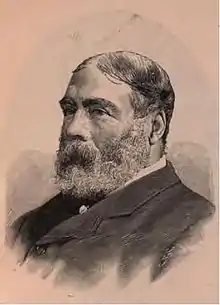
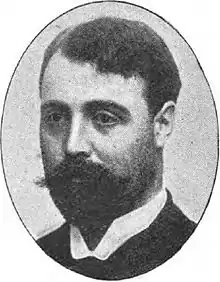
| Party | Candidate | Votes | % | ±% | |
|---|---|---|---|---|---|
| Liberal | William Wills | 4,129 | 68.8 | +17.6 | |
| Ind. Labour Party | Samuel George Hobson | 1,874 | 31.2 | New | |
| Majority | 2,255 | 37.6 | +35.2 | ||
| Turnout | 6,003 | 53.3 | -11.5 | ||
| Registered electors | 11,254 | ||||
| Liberal hold | Swing | N/A | |||
| Party | Candidate | Votes | % | ±% | |
|---|---|---|---|---|---|
| Liberal | William Wills | 3,740 | 51.2 | N/A | |
| Independent Labour | Hugh Holmes Gore[n 5] | 3,558 | 48.8 | New | |
| Majority | 182 | 2.4 | N/A | ||
| Turnout | 7,298 | 64.8 | N/A | ||
| Registered electors | 11,254 | ||||
| Liberal hold | Swing | N/A | |||
| Party | Candidate | Votes | % | ±% | |
|---|---|---|---|---|---|
| Liberal | Joseph Dodge Weston | Unopposed | |||
| Liberal hold | |||||
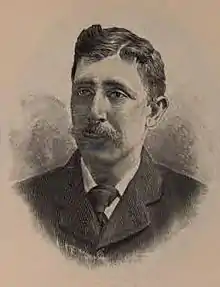
| Party | Candidate | Votes | % | ±% | |
|---|---|---|---|---|---|
| Liberal | Joseph Dodge Weston | 4,775 | 65.6 | +0.1 | |
| Conservative | James Inskip | 1,900 | 26.1 | −8.4 | |
| Independent Labour | Havelock Wilson | 602 | 8.3 | New | |
| Majority | 2,875 | 39.5 | +8.5 | ||
| Turnout | 7,277 | 70.6 | +11.6 | ||
| Registered electors | 10,310 | ||||
| Liberal hold | Swing | +4.3 | |||
Elections in the 1880s
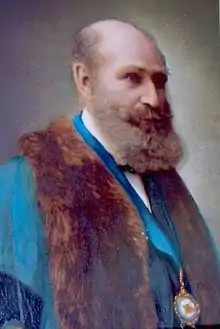
| Party | Candidate | Votes | % | ±% | |
|---|---|---|---|---|---|
| Liberal | Handel Cossham | 3,672 | 65.5 | -0.6 | |
| Conservative | James Inskip | 1,936 | 34.5 | +0.6 | |
| Majority | 1,736 | 31.0 | -1.2 | ||
| Turnout | 5,608 | 59.0 | -15.0 | ||
| Registered electors | 9,506 | ||||
| Liberal hold | Swing | -0.6 | |||
| Party | Candidate | Votes | % | ±% | |
|---|---|---|---|---|---|
| Liberal | Handel Cossham | 4,647 | 66.1 | ||
| Conservative | James Broad Bissell | 2,383 | 33.9 | ||
| Majority | 2,264 | 32.2 | |||
| Turnout | 7,030 | 74.0 | |||
| Registered electors | 9,506 | ||||
| Liberal win (new seat) | |||||
Notes
- A borough constituency (for the purposes of election expenses and type of returning officer)
- As with all constituencies, the constituency elects one Member of Parliament (MP) by the first past the post system of election at least every five years.
- See the Redistribution of Seats Act 1885
- Including two re-elections of Corston, who was later elevated to the House of Lords as Baroness Corston
- Supported by the Bristol Socialist Party and the Independent Labour Party
References
- "Bristol East: Usual Resident Population, 2011". Neighbourhood Statistics. Office for National Statistics. Archived from the original on 4 February 2015. Retrieved 3 February 2015.
- "England Parliamentary electorates 2010-2018". Boundary Commission for England. Archived from the original on 23 March 2019. Retrieved 23 March 2019.
- "'Bristol East', June 1983 up to May 1997". ElectionWeb Project. Cognitive Computing Limited. Archived from the original on 11 March 2016. Retrieved 10 March 2016.
- "Labour Members of Parliament 2015". UK Political.info. Archived from the original on 29 September 2018.
- "Bristol East 1885-1950". Parliamentary Debates (Hansard). Archived from the original on 16 November 2014. Retrieved 2 February 2015.
- "Bristol East 1983-". Parliamentary Debates (Hansard). Archived from the original on 16 January 2016. Retrieved 2 February 2015.
- "Statement of Persons Nominated". Archived from the original on 13 December 2019. Retrieved 13 December 2019.
- Ashcroft, Esme (18 April 2017). "Bristol's four MPs will all be defending their seats in the general election". bristolpost. Archived from the original on 24 April 2017. Retrieved 23 April 2017.
- "Bristol East". BBC. Archived from the original on 16 December 2019. Retrieved 9 June 2017.
- "Election Data 2015". Electoral Calculus. Archived from the original on 17 October 2015. Retrieved 17 October 2015.
- "South West Green Party | SW Constituency Map". Archived from the original on 21 February 2015. Retrieved 21 February 2015.
- "TUSC parliamentary candidates in May 2015" (PDF). Trade Unionist and Socialist Coalition. 4 February 2015. Archived (PDF) from the original on 7 February 2015.
- "Bristol East result". BBC Election 2010. BBC. 20 April 2010. Archived from the original on 27 February 2017. Retrieved 7 May 2010.
- "Election Data 2010". Electoral Calculus. Archived from the original on 26 July 2013. Retrieved 17 October 2015.
- "Election Data 2005". Electoral Calculus. Archived from the original on 15 October 2011. Retrieved 18 October 2015.
- "Election Data 2001". Electoral Calculus. Archived from the original on 15 October 2011. Retrieved 18 October 2015.
- "Election Data 1997". Electoral Calculus. Archived from the original on 15 October 2011. Retrieved 18 October 2015.
- "Politics Resources". Election 1992. Politics Resources. 9 April 1992. Archived from the original on 24 July 2011. Retrieved 6 December 2010.
- "Election Data 1992". Electoral Calculus. Archived from the original on 15 October 2011. Retrieved 18 October 2015.
- "Election Data 1987". Electoral Calculus. Archived from the original on 15 October 2011. Retrieved 18 October 2015.
- "Election Data 1983". Electoral Calculus. Archived from the original on 15 October 2011. Retrieved 18 October 2015.
- Cooke, Colin (1957) The Life of Richard Stafford Cripps, p.119
- Standard 21 June 1913
- British Parliamentary Election Results 1885-1918, FWS Craig
- Debrett's House of Commons & Judicial Bench, 1916
- The Liberal Year Book, 1907
- Debrett's House of Commons & Judicial Bench, 1901
- Debrett's House of Commons & Judicial Bench, 1886
Sources
- British Parliamentary Election Results 1885–1918, compiled and edited by F.W.S. Craig (The Macmillan Press 1974)
External links
- nomis Constituency Profile for Bristol East — presenting data from the ONS annual population survey and other official statistics.
- Interviews with the 2005 parliamentary candidates
